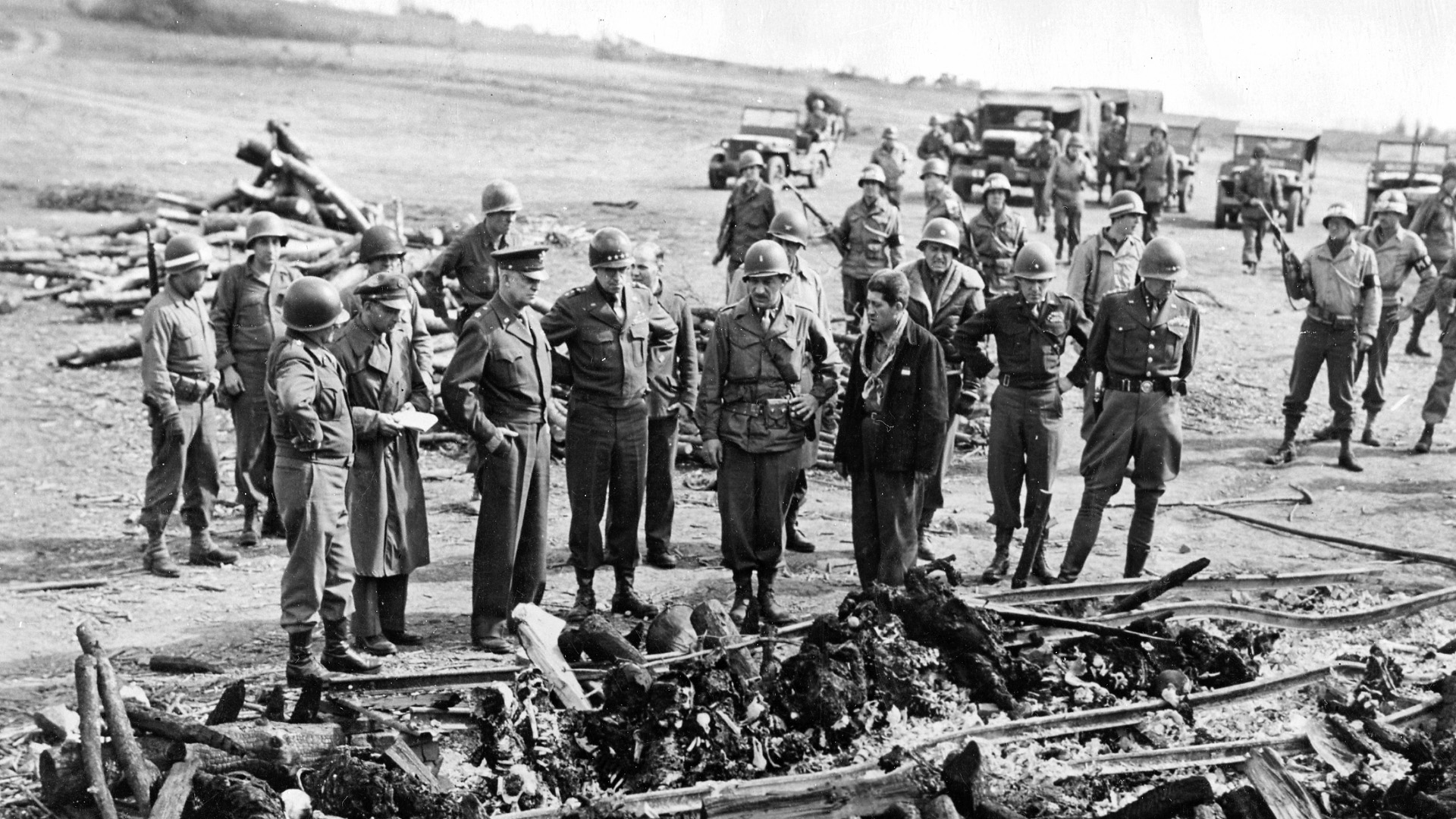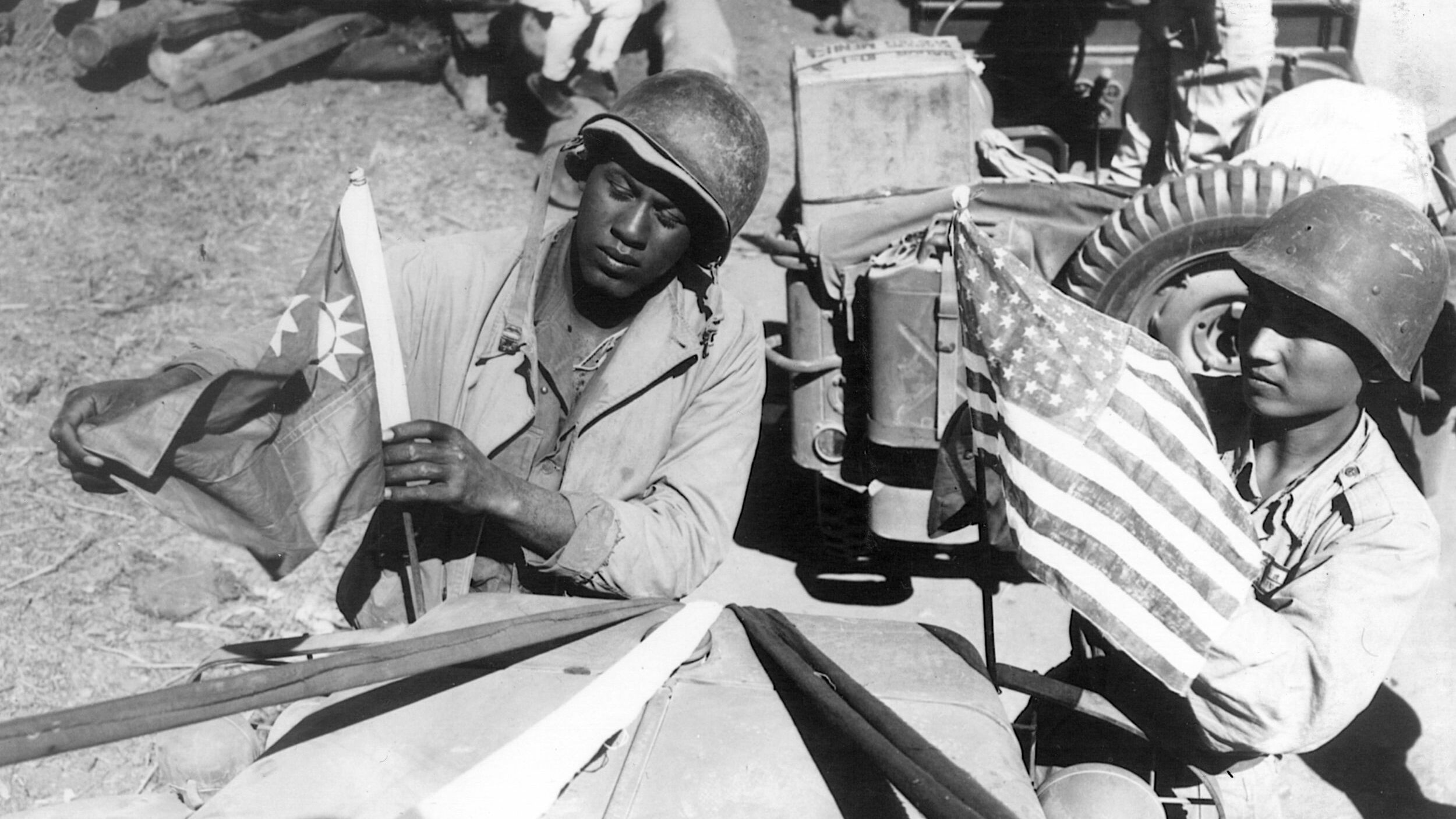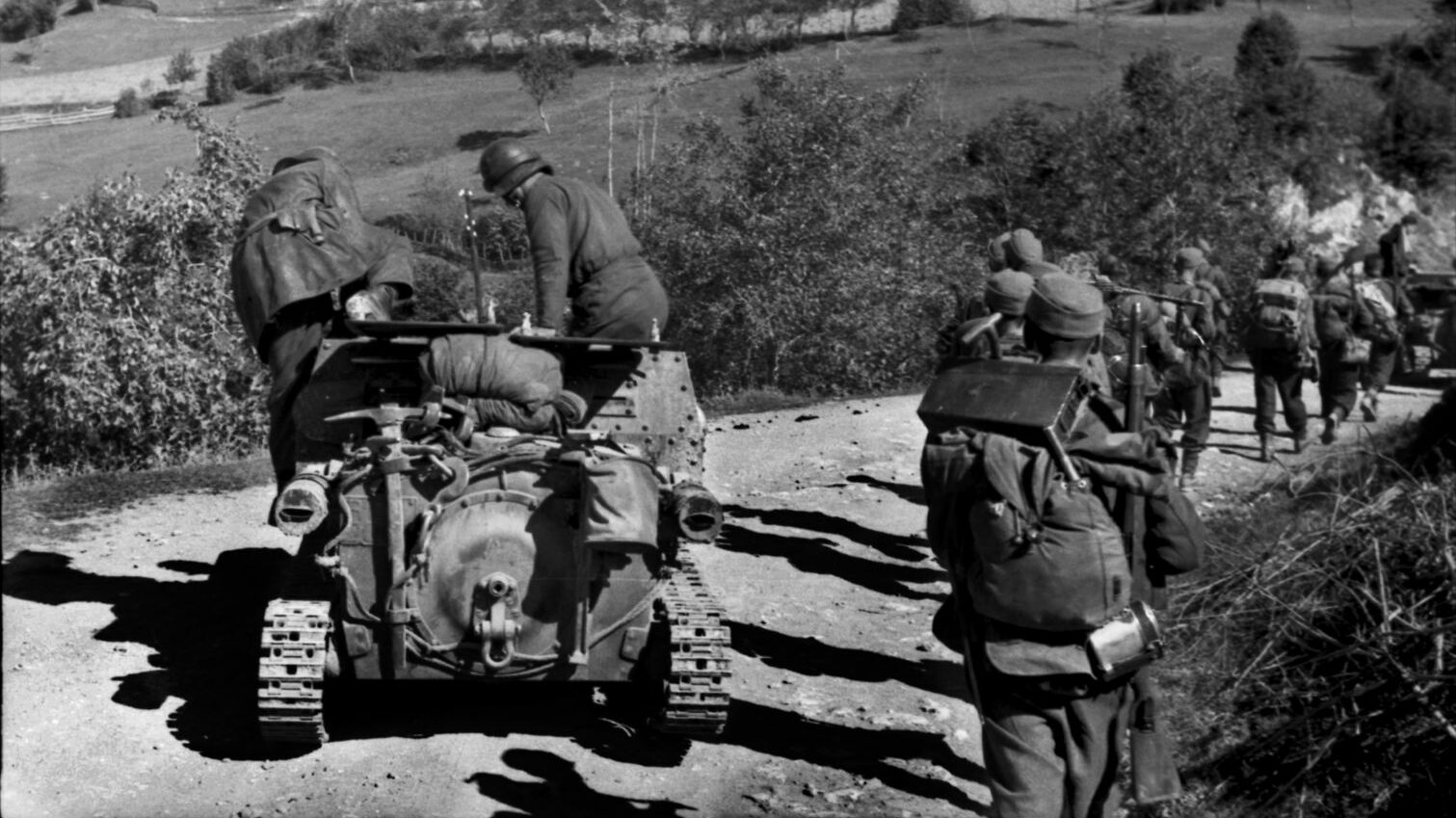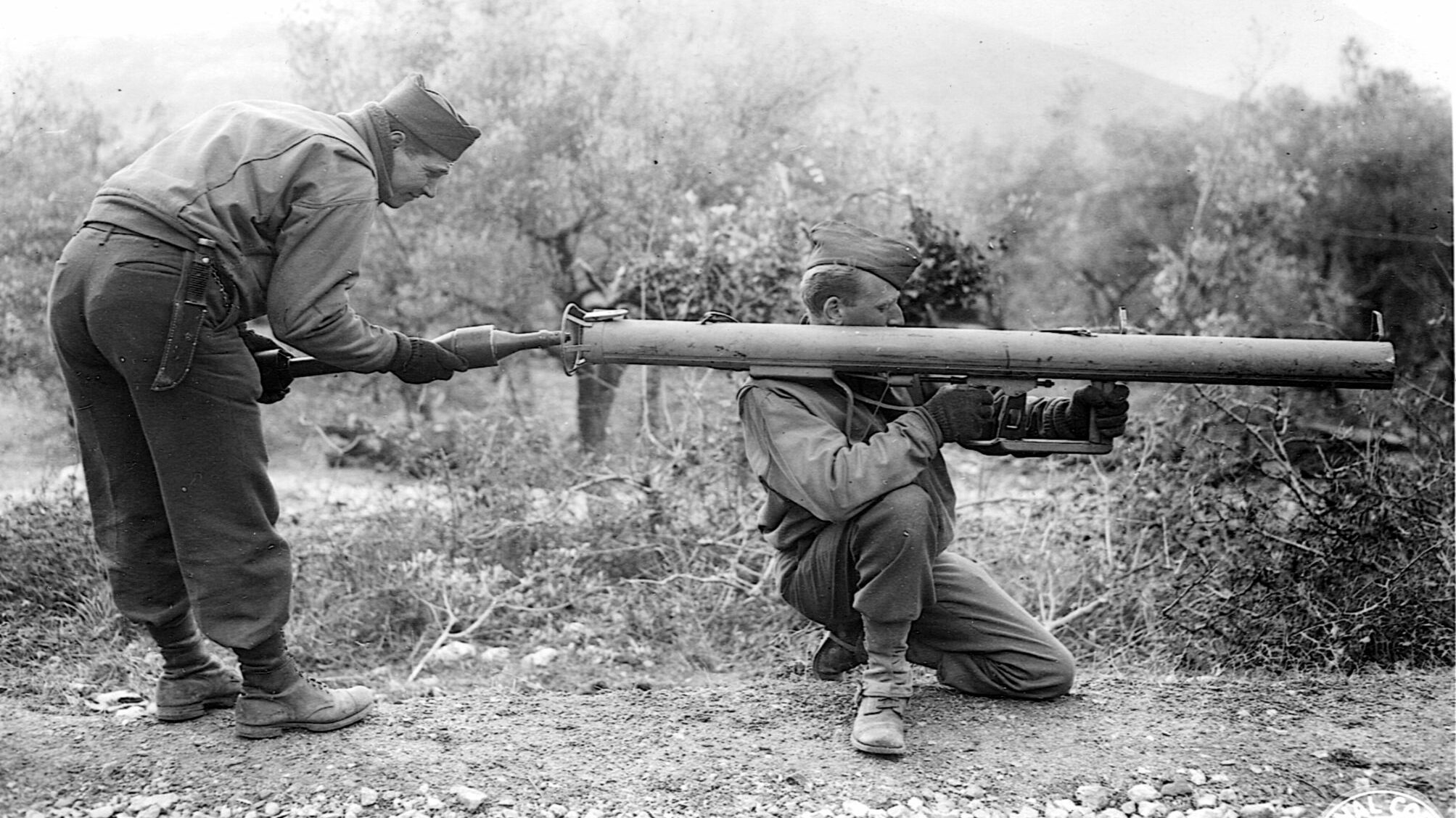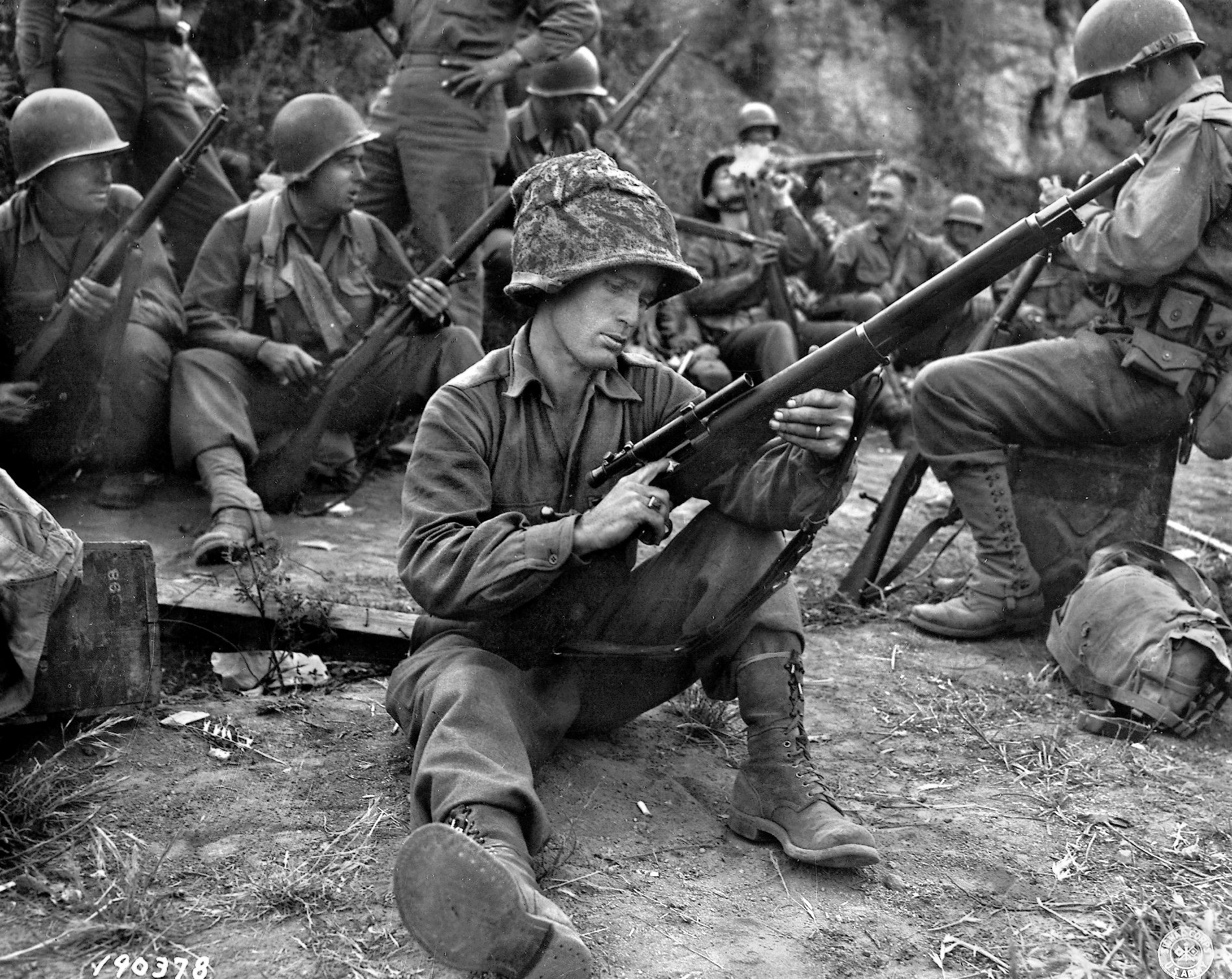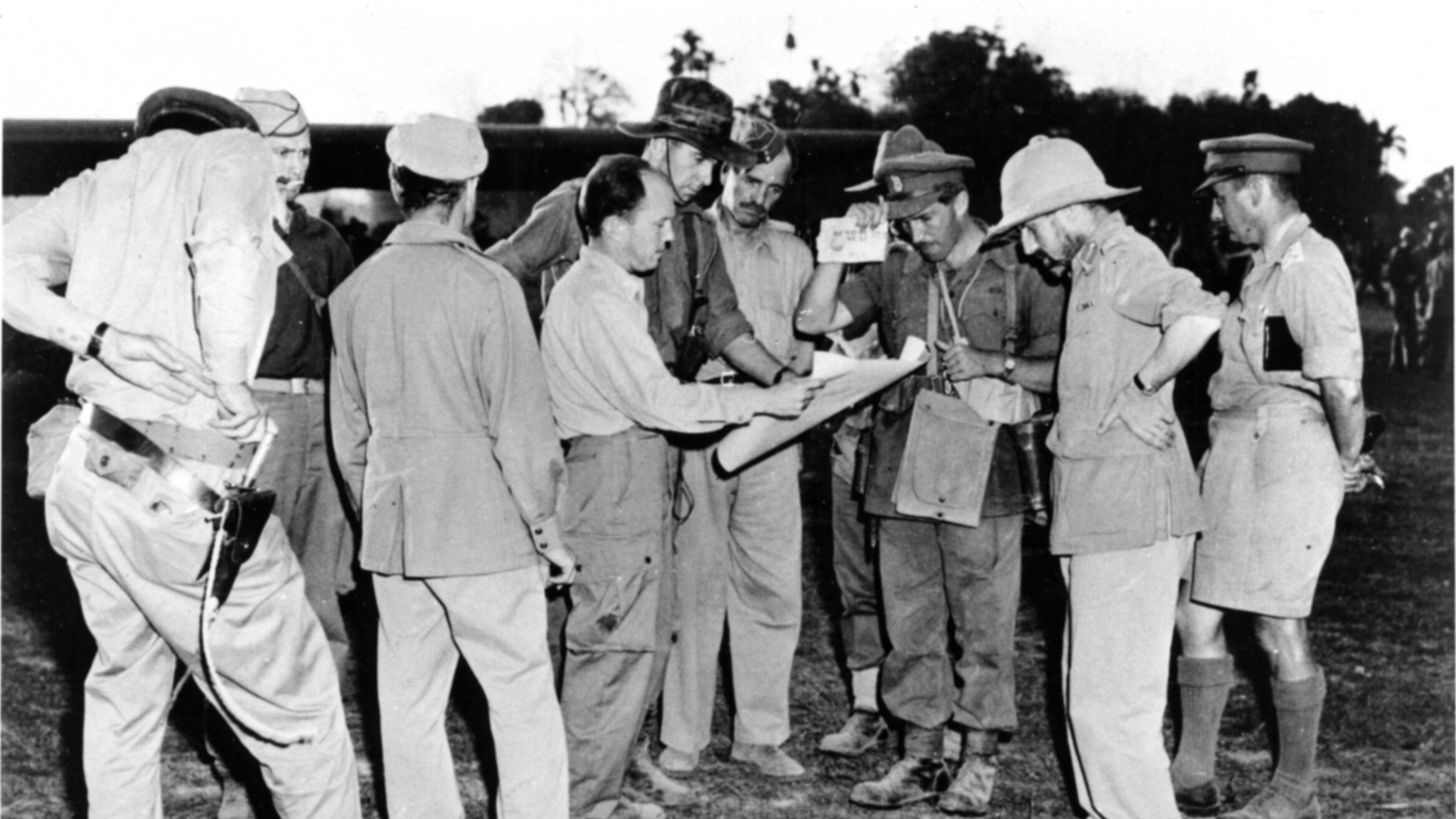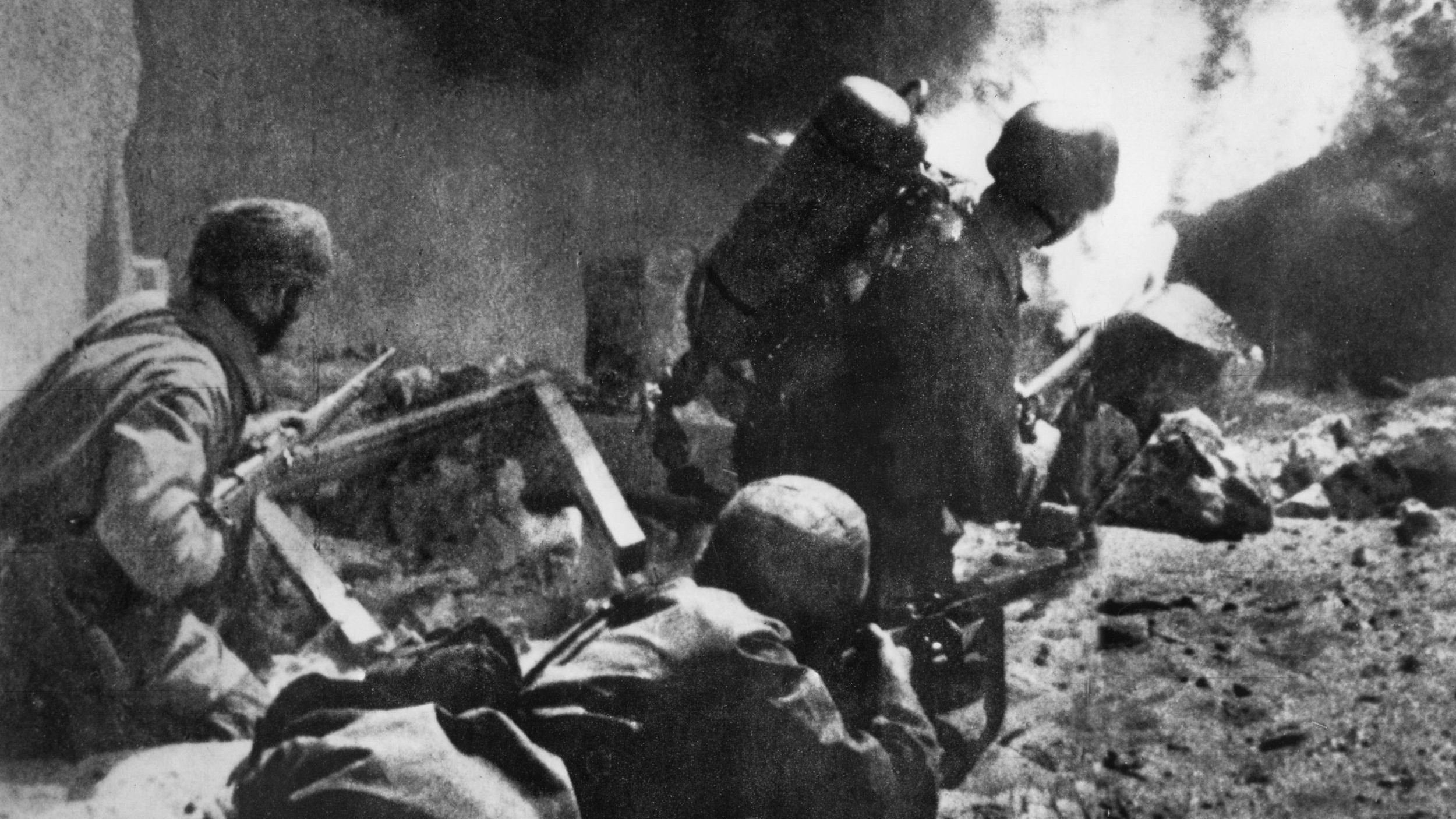By Flint Whitlock
The blue arrows on Lt. Gen. George S. Patton, Jr.’s Third Army situation maps in his mobile headquarters trailer all pointed eastward. From the vicinity of Frankfurt-am-Main, Patton’s three corps—Troy Middleton’s VIII, Manton Eddy’s XII, and Maj. Gen. Walton H. Walker’s XX—were plunging side by side over hills, across rivers, streams, and fields, through woods, and into towns and villages, through barricades, road blocks, and minefields, destroying all efforts by the Germans to slow the advance. This was all before the true horrors of the Nazi regime were known to Allied forces. Patton’s army had yet to learn of the atrocities that were taking place at Ohrdruf and the Buchenwald Concentration Camp. But that day was fast approaching.
Since August 1944, the XII and XX Corps had been the main striking arms of Patton’s Third Army and, as such, had blazed a trail from the western coast of France, through Belgium, and into Germany. The divisions that composed Walker’s XX Corps from the middle to the end of March 1945 were the 6th, 10th, 11th, and 12th Armored Divisions, and the 5th, 26th, 65th, 80th, and 94th Infantry Divisions. During that same period, making up Manton S. Eddy’s XII Corps (which had been attached to Third Army on August 1, 1944), were the 4th Armored Division and the 76th, 89th, and 90th Infantry Divisions.
Middleton’s VIII Corps, which had been added to Third Army on December 20, 1944, shortly before Middleton’s units were mauled during the Battle of the Bulge, consisted only of the 87th and 89th Infantry Divisions. All told, the three corps that made up Patton’s Third Army totaled some 203,000 men.
By mid-March, Walker’s XX Corps had taken Trier, Saarlautern, and Kaiserslautern. By March 21, Walker’s advance elements had reached both the Rhine and the Main, then crossed both rivers and took Mainz, Wiesbaden, and Frankfurt. Eddy’s XII Corps, too, had progressed well, crossing the Mosel River on March 14 and capturing Bad Kreuznach on March 18 and Worms three days later. For six days—March 21-27—XII Corps battled for and seized Mainz in conjunction with XX Corps. On the 22nd, XII Corps assaulted across the Rhine River at Oppenheim where it pummeled the German defenders.
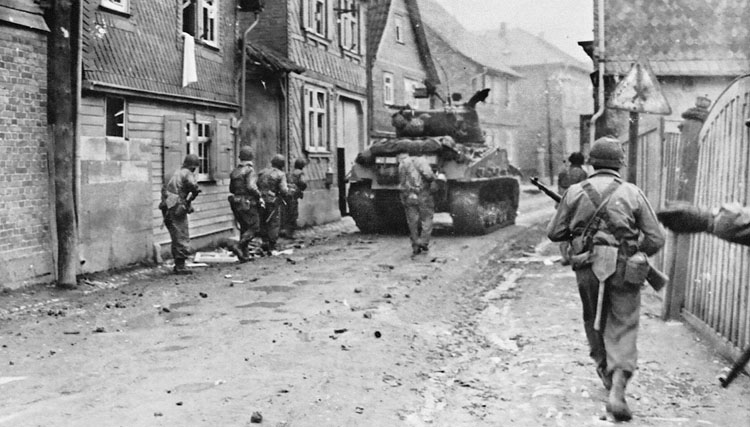
Middleton’s VIII Corps followed behind the spearhead units and performed “mopping-up” operations, i.e., eliminating pockets of resistance that were bypassed by the lead units in order to keep the advance from stalling.
By the end of March, the 4th and 6th Armored Divisions were seasoned, battle-hardened units. Highly regarded was Maj. Gen. William M. Hoge’s 4th Armored Division, which had come ashore with VIII Corps at Utah Beach, Normandy, France, on July 11, 1944, and proceeded to cut a bloody swath through the Germans all across Western Europe.
During the Battle of the Bulge in December 1944, 4th Armored was one of the key elements that made a historic winter march in record time to help break the siege on American forces at Bastogne, Belgium, thus earning the sobriquet “Patton’s Best.” So feared was the 4th that the Germans referred to the outfit as “Roosevelt’s SS.”
Transferred from VIII Corps to XII Corps in January 1945, the 4th Armored was the tip of the spear for much of Patton’s bold dash toward Germany—and into the history books.
A Fleeting Glimpse of Evil
Major General Robert W. Grow’s 6th Armored Division had also seen plenty of combat since arriving at Utah Beach eight days after the 4th Armored. Like the 4th, the 6th also took part in the action to relieve besieged Bastogne. The 6th crossed the Rhine on March 25, bulldozed its way through heavy opposition at Frankfurt-am-Main, and then headed in a northeastern direction toward Kassel.
On March 30, Grow’s tankers saw firsthand the evidence of Nazi cruelty. The division’s newspaper, Armored Attacker, reported that the 6th came across a camp of 900 Hungarian Jewish women near Homburg, a town about 22 miles southwest of Kassel:
“Most of the 900 had been working in munitions and poisonous-gas factories under incredibly hard slave-labor conditions. For months they had received only one bowl of water-like soup and two pieces of bread per day, wore wooden shoes and burlap-like garments, and had no soap with which to wash. The women were under the strict control of SS troops, who shaved their heads…. The most horrible part of the story concerned the treatment received by the women who became too ill to work. They were disrobed, thrown on trucks with the already dead and their fate then became unknown.”
Even this initial encounter with evil did not fully prepare the men of the division for what they would discover in just a fortnight.
Extermination, or “Liberation”? How Heinrich Himmler Tried to Cover His Tracks
For the leaders of the Third Reich, the writing on the wall spoke very clearly about a bad end looming for them. The SS chief, Heinrich Himmler, was especially worried about his fate if the Allies should capture him. The trail of blood and ashes from millions of victims of the SS led directly to his doorstep, and he began to think of ways he might be able to escape the hangman’s noose.
One thing he could do, he believed, was to try and cover up the magnitude of his and the SS’s crimes. To accomplish that, he had but two choices: either murder all of the remaining inmates of the concentration and death camps and dispose of their bodies, or open the gates of the camps, march the inmates out, and allow the Allies to find only empty barracks.
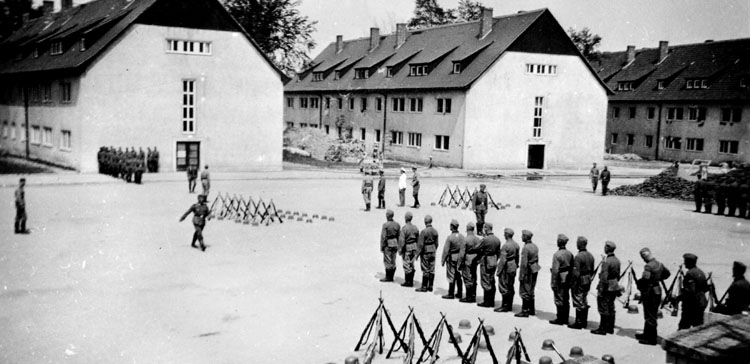
The problem with the first option was simply that Nazi Germany was running out of time. No matter how efficient the Nazis’ mass murder system had become, it would still take weeks, and possibly even months, to kill the hundreds of thousands of people still in the camps and working at slave-labor jobs, and then burn or bury the corpses.
Himmler feared, and rightly so, that Nazi Germany no longer had weeks or months left to take care of such an enormous task. Added to this problem was the fact that the extermination facilities in Poland were no longer in existence, all of them having either been abandoned or captured by the advancing Red Army.
The second option seemed much more workable. The camps could be evacuated and the inmates marched into the countryside where, devoid of food and medical care, they would begin to die in droves. If Allied armies came across the bodies, Himmler’s excuse could be that the inmates had escaped from the camps and, without the care offered by their SS warders, died on their own.
If liberating units came close to a group of inmates on the march, the prisoners could be killed en masse by their guards, who would then shed their uniforms and disappear into the woods. No witnesses, no prosecution. Perhaps a case could even be made that the Allied troops had gunned down the inmates, either on purpose or by accident.
Yes, this was the only way Himmler believed he could save himself. And one of the first camps he ordered emptied was a slave-labor camp known as Ohrdruf-Nord Stalag III, located near the quaint, attractive Thuringian town of Ohrdruf, founded in the eighth century by Saint Boniface, about 30 miles west of Weimar.
Ohrdruf: from Johann Sebastian Bach to The Nazi’s “S-III”
In 1625, the 10-year-old Johann Sebastian Bach came to live with his brother in the town, play the organ, and compose music at the Church of Saint Michael. During the 1800s, Ohrdruf became a center for the manufacture of toys (such as the Kewpie doll), as well as the site of a military training ground (Truppenübungsplatz) that was created to prepare troops for the Franco-Prussian War of 1870-1871.
In the late 1930s, the military facilities at Ohrdruf were home to a modest underground Wehrmacht communications center called Amt 10 (“Office 10”), which had been started but not completed some five and a half miles east-southeast of Ohrdruf in the limestone cliffs of a valley known as the Jonastal. It became one of the Nazis’ major underground construction projects—Sonderbauvorhaben III, or S-III.
Highly secret and well guarded, S-III was a huge, multi-level tunnel system with some shafts more than 1½ miles in length, hidden using shaft entrances disguised to look like chalets.
Owing to the severe aerial pounding that Berlin and other German cities were taking from American and British bombers, S-III was greatly expanded beginning in the summer of 1944, in anticipation that Hitler and the Nazi high command might need to relocate there. Doing the expanding and upgrading were 1,000 slave laborers from KL (for Konzentrationslager, or concentration camp) Buchenwald.
What the Buchenwald Concentration Camp Was Used for
To house the slave work force, the Buchenwald sub-camp of Ohrdruf-Nord Stalag III was established in October 1944. By the end of January 1945, some 12,000 slave laborers were crammed into this small camp.
Given the severity of the work, brutal treatment at the hands of their guards, and their meager diet—not to mention work site accidents—prisoners died in droves. During his war crimes trial, SS physician Dr. Werner Greunuss testified that some 15-20 percent of the inmates died or were killed during his time at Ohrdruf.
There was still much confusion in Berlin as to what should be done with the bloated camps and their inmates. Himmler still dithered, continually suffering from second thoughts, changes of mind, and agonizing stomach cramps. In an effort to prove that he wasn’t a heartless monster, Himmler issued an order to the camp commandants to spare all still living Jewish camp prisoners, including giving them sufficient rations and providing all necessary medical care to keep them alive.
On March 20, 1945, Oswald Pohl, head of the economic administration of the SS, visited Buchenwald, located high on a hill known as the Ettersberg overlooking Weimar, and reiterated to the commandant, Hermann Pister, Himmler’s earlier order to spare Jewish prisoners. But time was running out.
The March from Ohrdruf to Buchenwald
On March 23, the British and Canadians crossed the northern Rhine in Operation Plunder. Heinz Guderian, one of the last generals Hitler could trust, went to the Führer, tried to explain the rapidly deteriorating military situation, and pleaded with him to conclude an armistice with the Western Allies. Hitler fired him on the spot.
The next day the largest and most successful airborne and glider operation of the war—Operation Varsity—took place in the vicinity of Wesel, Germany.
Three days later, from its last remaining launch site near The Hague in Belgium, Germany fired its final salvo of V-2 ballistic missiles; hundreds of other sites had already been overrun or wiped out by aerial attacks. Guderian’s warnings proved to be true; before the month was over, Soviet troops were pressing Germany in the East and the Americans and British were about to encircle the Ruhr.
Like Himmler, Nazi Propaganda Minister Joseph Goebbels realized that the Allied discovery of the camps would mean death for the Nazi leadership if they were caught. In early April, he noted, “I fear that the concentration camps have grown a bit above Himmler’s head. Just suppose that these camps should be overrun by the enemy in their present condition. What an outcry would be heard.”
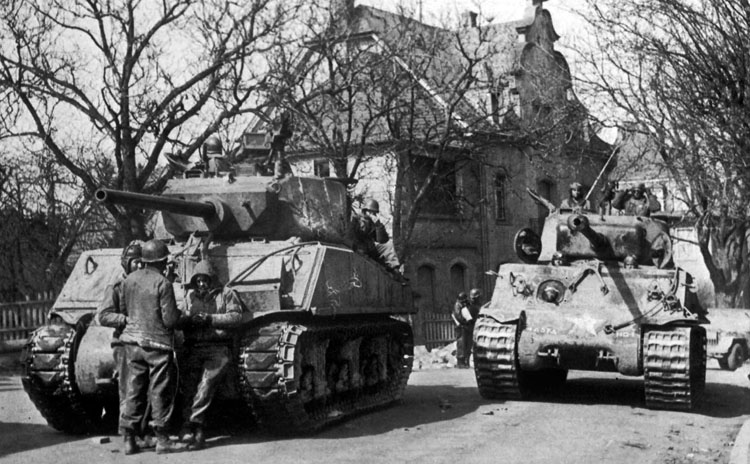
Himmler knew he faced Hitler’s wrath—or worse—by countermanding his Führer’s orders, and his nervous condition also deteriorated, but this was the only straw worth grasping. Himmler began secret negotiations with Count Folke Bernadotte, vice-president of the Swedish Red Cross.
He arranged for the removal of Danish and Norwegian prisoners at the Mittelbau-Dora camp, where the V-2s were assembled. They would be transported to Neuengamme, where the Swedish Red Cross would look after them, then three transports filled with a total of 2,900 inmates departed for Bergen-Belsen where, presumably, they were killed.
At the beginning of April, nearly 10,000 prisoners were marched from Ohrdruf to Buchenwald. Those judged too sick or infirm to make the three-day, 30-mile march were either shot or beaten to death by the guards. Only a few hundred prisoners remained behind.
Time Runs Out for the Nazi Command
Hermann Pister, the Buchenwald commandant, was also worried that if the Americans, British, or Soviets showed up before evidence of their crimes could be erased, every German associated with the camp would be summarily executed. Such an ending must not be allowed to happen.
A roll call taken on April 1 showed a total of 80,813 inmates assigned to the Buchenwald concentration camp, with approximately 34,000 of that number working off-site at sub-camps (such as Ohrdruf) and armaments works.
Himmler gave orders to the camp commandants to halt the evacuations and executions of prisoners and leave the camps intact for the Allies to liberate. It was an order that did not long remain in force, for American troops were coming dangerously close to the hell holes of Mittelbau-Dora, Ohrdruf, and Buchenwald, and Himmler suddenly lost his nerve, deciding not to countermand Hitler’s wishes.
Here the historical record gets confused. According to Himmler’s biographers Roger Manvell and Heinrich Fraenkel, “[Ernst] Kaltenbrunner [the head of the RSHA, Reich Security Main Office] had ordered the wholesale evacuation of Buchenwald which began, probably without Himmler’s knowledge, on 3 April. Himmler, says [Walter] Schellenberg, stopped the evacuation on 10 April as soon as he learned of it from the son of the Swiss President, Jean-Marie Musi, to whom on 7 April he had given his word that Buchenwald should be left intact for the Allied liberation, a promise intended to impress General Eisenhower in Himmler’s favour.”
Schellenberg’s intervention, however, came too late—the evacuation had already begun, and tens of thousands of prisoners were trudging the countryside on forced marches under armed guard.
The Situation with Patton’s Forces
Before the battle to take Mühlhausen began on April 4, XX Corps’ General Grow received an order from Patton to change his direction. The 6th Armored was to advance “with all possible speed and take the cities of Weimar and Erfurt.” The 4th Armored would also head toward Gotha.
Accompanying the 6th Armored was the 80th Infantry Division, while the 76th Infantry Division was paired with 4th Armored.
Of the two infantry divisions assigned to accompany the tankers, only the 80th could be considered an experienced outfit. Maj. Gen. Horace L. McBride’s “Blue Ridge” boys had entered Europe at Utah Beach in August 1944 then proceeded to fight their way eastward with barely a break in the action.
Like the 4th and 6th Armored Divisions, the 80th was hurled against the German breakthrough during the Battle of the Bulge and contributed to restoring the shattered American front lines.
By contrast, Maj. Gen. William R. Schmidt’s 76th Infantry Division had been in combat only since early February 1945. Although it had seen a few skirmishes, the 76th was still relatively new to the rigors of combat and the horrors of war.
Assisting these units in a mopping-up role were Maj. Gen. Frank L. Culin, Jr.’s 87th and Maj. Gen. Thomas D. Finley’s 89th Infantry Divisions. The 87th had not seen its first action until December 8, 1944, near Metz, France, but was in the thick of fighting at the end of December during the Battle of the Bulge. The division also was engaged in the U.S. Army’s attempts to crack Germany’s vaunted West Wall—the so-called Siegfried Line.
The least experienced of the Third Army’s combat divisions heading eastward was the 89th Infantry Division. Although it did not arrive in Europe until January 1945 and did not receive its baptism of fire until March 11, the 89th was champing at the bit, eager to meet the enemy.
Would Patton Go to Ohrdruf?
The American military machine was making good progress across Germany on its drive to link up with the Soviets at the Elbe River. But 12th Army Group commander Omar Bradley considered slowing down or halting Patton’s Third Army to prevent a salient from forming while at the same time pushing Courtney Hodges’s First Army to catch up with Patton’s forward elements and straighten the front line.
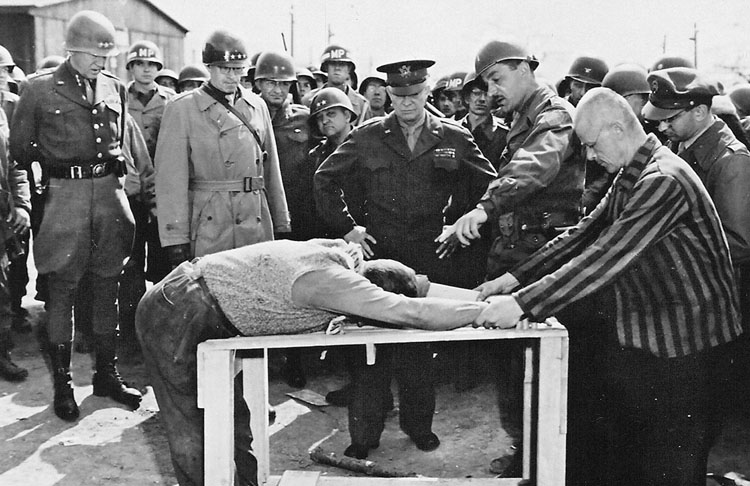
Patton was told to halt, but the 12th Army Group then received intelligence obtained from a German officer deserter regarding a vast underground German communications center at Ohrdruf. The details were sketchy but enticing, and when First Army reported that it would be unable to reach the line of the Third Army’s advance any time soon, Bradley gave Patton the go ahead to push on to Ohrdruf.
Patton recalled, “[Bradley] had a plan for the capture of the German communication center in the vicinity of Gotha, Erfurt, Weimar, and Ohrdruf, which, when he explained it to me, seemed full of promise…. We explained the idea of the rapid advance on the Weimar Quadrilateral—Eddy on the right, Walker on the left [and Middleton in reserve]. I told them they would have the greatest chance in history to make names for themselves, and to get moving.”
Apparently nothing, however, was then known about a possible slave-labor camp at Ohrdruf. Most of the U.S. Army and the American public at large had been kept in the dark about the existence of concentration or extermination camps. Buchenwald and Ohrdruf had been two of 40,000 slave-labor, concentration, and extermination camps the Germans had operated since 1933, the year Hitler and his Nazi Party had come to power.
Atrocities Too Terrible for the American Public to Be Believed
Of course, there had been news reports in the New York Times as early as March 1933 that the Hitler regime was persecuting certain segments of its population, especially Jews. At that time, a series of measures adopted overwhelmingly in 1935 by the Reichstag (Parliament), called the Nuremberg Laws, had stripped every German Jew of virtually every right he or she once enjoyed. Their homes and businesses were taken from them, and onerous restrictions were placed on their everyday activities.
But the vast numbers of skeptical Americans (and Britons too, for that matter) regarded such reports as unfounded rumors designed to whip up anti-German sentiment as had happened during World War I.
And so, as Hitler’s armies began overrunning one country after another, the tales became even more fantastic—Russian villages wiped clean of their Jewish inhabitants, cities like Warsaw, where Jews were herded into overcrowded ghettos and guarded by armed soldiers, and special camps established where thousands of Jews and other political prisoners could be kept under lock and key. There were even rumors of experiments in mass murder.
Even the Soviet discovery, in January 1945, of an extermination factory at a place called Auschwitz in Poland was widely viewed with skepticism. It all seemed to be too terrible, too fantastic to be believed.
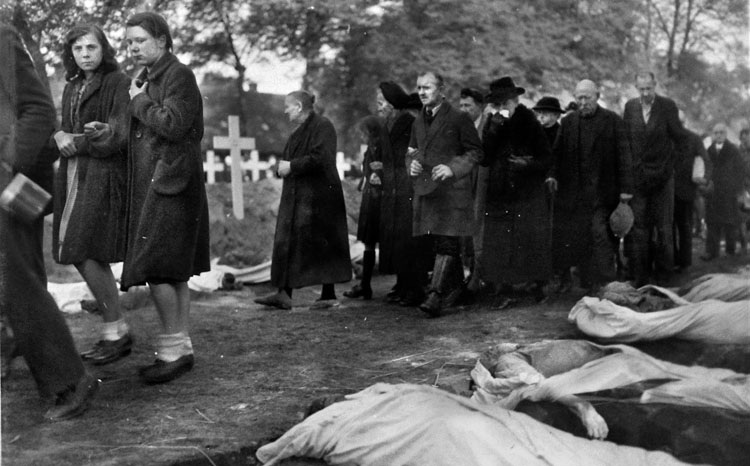
An 89th Recon Troop officer reported that his men entered Ohrdruf-Nord Stalag III on April 4, 1945, and “saw first-hand the horror of life in a Nazi concentration camp. In addition to finding the communications center, the Americans began pouring into [the camp], which was still littered with corpses. We radioed our troop headquarters for instructions and were told to remain there, keeping the inmates contained (this was hardly necessary, as most were in their bunks, hardly able to walk) while headquarters contacted the infantry to relieve us.” It took nearly three more hours before the 3rd Battalion of the 355th Infantry arrived and took control of the situation.
Low-Tech Genocide
Among the first GIs to enter the camp was Sol R. Brandell, a scout with the 355th Infantry Regiment’s Intelligence and Reconnaissance Platoon. He saw a small building with a sign, Krankenhaus—Achtung: Typhus (“Hospital—Warning: Typhus”) and went inside, only to be greeted by the sight and smell of “about 12 or 13 bodies lying in two-high wooden bunks and emitting the worst stench of rotten flesh, blood, and feces that I had ever before encountered—so intense that it stopped my breath and I had to escape to the outdoors, which didn’t smell as bad.”
After regaining his composure, Brandell went on a cursory inspection of the camp, coming across an immense pit that contained what he estimated to be the bodies of 6,000 to 7,000 naked corpses (a former inmate said there were 9,000 bodies), covered with a thin dusting of quick-lime.
Stanley N. Hodson, a private in the 355th Infantry, wandered over to another large pit, this one crisscrossed with a grid of warped steel rails and blackened logs on which burned bodies were still visible.
Hodson said, “There were long poles with steel hooks on them used for turning the bodies over. Even so, they didn’t do a good job. The bodies were still there, some only charred, some half burnt. Off to one side some graves were dug.”
The after-action report of Combat Command A, 4th Armored Division described the camp this way: “When the troops entered, they found 29 bodies on the ground in front of the administration building. A short distance away was a gallows and not far beyond it a shed in which 52 naked bodies were stacked in tiers of four, covered with what appeared to be powdered lime.
“They apparently had been awaiting transportation to pits in the forest where between two and three thousand others had been buried during the six months the camp had existed. Most had died of disease, but most also had marks on their faces and heads and bruises on their bodies. A third group of nine charred torsos lay among ashes under a rough incinerator made of railroad ties and rails. Those in front of the administration building were the most recently dead––all shot in the back of the neck.
“Ohrdruf-Nord had no gas chamber or high-performance crematorium. The deaths there were caused by disease and neglect, helped along by overwork and brutality…. In the succeeding days the guards had marched those who could walk away to the east…. A dozen men had hidden in the camp buildings and survived to tell about the last days at Ohrdruf-Nord and to identify the dead…”
Colonel Hayden A. Sears, commander of the 4th Armored’s Combat Command A, ordered 25 citizens of Ohrdruf to visit the concentration camp the next day “to view the ghastly scene left by their army. Forty-six [SS] prisoners were captured by CC ‘A’ in patrol activities around Ohrdruf. The mayor and his wife, while professing no knowledge of the affairs of the camp, later committed suicide,” Sears said.
The Discovery of the Buchenwald Concentration Camp
In his headquarters at Bad Hersfeld, Germany, Patton was planning the next phase of his drive farther east when he received reports about the discovery of Ohrdruf. Patton telephoned Bradley, who later wrote, “Third Army had overrun Ohrdruf, the first of the Nazi death camps … and George insisted that we view it. He said, ‘Brad, you’ll never believe how bastardly these Krauts can be until you’ve seen this pesthole yourself.’”
Plans were made for Patton, Bradley, Eisenhower, and other top brass to visit Ohrdruf-Nord on April 12. The day before that happened, however, another, even larger concentration camp—KL Buchenwald—was accidentally discovered.
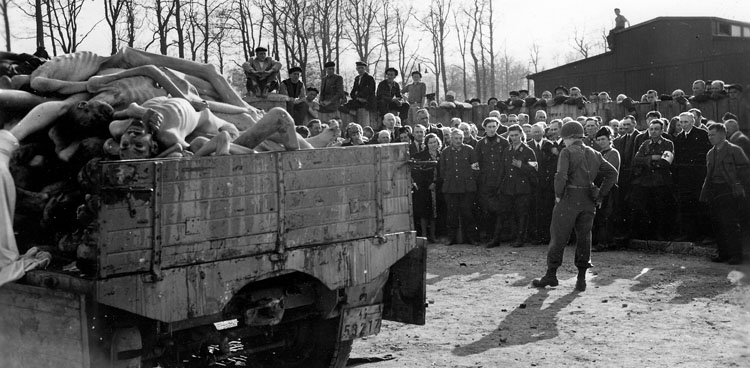
On April 11, as a small, advance patrol from the 6th Armored Division, led by Captain Frederic Keffer, headed toward Weimar and was approaching the western outskirts at a village called Hottelstedt, they were fired upon by a group of SS soldiers. A brief firefight took place and then the SS broke contact.
No sooner had the skirmish ended than a small group of bedraggled men came straggling down the road, jabbering in what sounded like Russian. Luckily, a Russian-speaking GI was with Keffer’s group and he told Keffer that a huge concentration camp called Buchenwald was very close.
None of the Americans knew what a concentration camp was, or had even been informed that one was in the vicinity (Army maps did not contain that information), but Keffer was intent on finding it. With the escaped prisoners riding atop Keffer’s armored cars, the group traveled the mile or so from Hottelstedt until they came to a clearing in the forest that ringed the camp.
There, they saw behind barbed wire fences scores of barracks, guard towers, and more than 20,000 men in ragged, striped uniforms rushing toward them and cheering. A hole had been cut in the barbed wire enclosure and, upon entering, the Americans were immediately swarmed by the now-liberated, foul-smelling, deliriously happy inmates, all of them excitedly cheering and babbling in incomprehensible tongues.
Keffer was told the name of the camp, but the name “Buchenwald” had little meaning for him at that time. Suddenly, Keffer found himself lifted off the ground by a score of hands and carried around “on the shoulders of the crowd like a conquering hero.”
He later wrote, “What an incredible greeting that was. I was picked up by arms and legs, thrown in the air, caught, thrown again, caught, thrown, etc., until I had to stop it, I was getting so dizzy. How the men found such a surge of strength in their emaciated condition was one of those bodily wonders in which the spirit sometimes overcomes all weaknesses of the flesh. My, but it was a great day!”
Teenage inmate Louis Gros said that he caught a glimpse of Keffer entering the camp: “He enters at a walking pace. We don’t have the time to discern whether he smiles or not. And why should he smile? In half a tick, we discover that his uniform … his officer’s insignia, shoes, and behavior can belong only to an American. And that one is our liberator, the first to enter the camp, to confirm our state as free men—free and rescued from the Nazi tyranny, definitely!
“Then 12 arms, maybe more, apprehend him, raise and throw him into the air, once, twice, ten times! He literally flies, such as a disjointed puppet until, tired of that exhausting sport, he shouts a forcible ‘Stop!’, which is promptly obeyed. Sensing that scene, I suddenly feel taken by an intense emotion. My tears release irresistibly because they have been repressed for too long a time. I have no shame; never have I felt so alive, so existing, than at that supreme instant!”
At that point, Keffer and his men were informed that, when the sounds of battle erupted from the direction of Hottelstedt, it was the signal for the prisoner revolt to begin. For years, the inmates had been stealing weapons and squirreling them away in anticipation for just this day. When it came, the inmates battled with their SS guards, driving many of them away. The camp was now in possession of the prisoners.
Keffer said, “I was slowly pulled and pushed through the crowd towards a headquarters building. There I met some of the leaders of the prison underground who were now in control. I told them I would radio for medical help and for food, and I requested them not to let the former prisoners, if they could help it, wander far outside the camp and possibly unwittingly interfere with our military progress.”
Lacking medicines or food in his small patrol, Keffer radioed back to his headquarters to tell what he had found and to request help to feed and care for the desperate inmates, many of whom were at death’s door.
Patton, Bradley, and Eisenhower Enter Room #8
The next day, April 12, was one of the most momentous days of the war. It began with a report that American soldiers had discovered a treasure trove of stolen artwork plus the majority of the Nazis’ gold reserves deep inside a vast salt mine at the town of Merkers, some 28 miles west of Gotha.
Patton, Bradley, and Eisenhower flew to Merkers to see firsthand this astounding discovery. A half mile underground, the three generals were escorted to Room #8—a massive cave filled with crates and bags of hundreds of millions of dollars worth of gold bullion, gold coins, platinum, banknotes, plus bags and boxes of gold wedding rings and gold teeth yanked from the mouths of the victims of the camps before they were fed into the ovens.
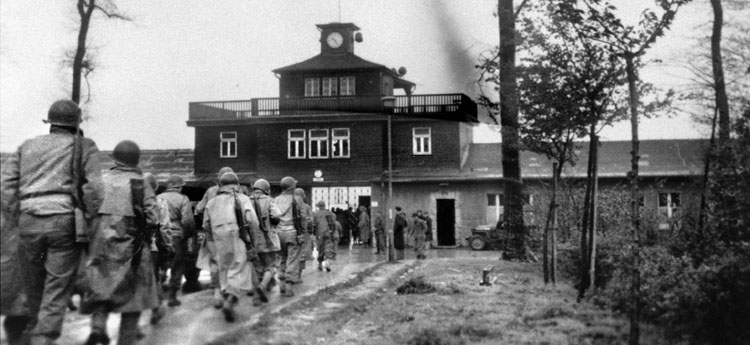
In an adjacent room, stacked in rows, were thousands of precious works of art that the Nazis had looted from hundreds of museums and galleries throughout occupied Europe.
After spending several hours underground, the generals returned to sunlight and, at the insistence of Walton Walker, headed to Ohrdruf. Patton said, “We drove to Ohrdruf and visited the first horror camp any of us had ever seen.”
The moment Ike, Bradley, Patton, Walker, their entourages, and a phalanx of photographers stepped through Ohrdruf’s barbed-wire gate, they sensed something sinister about the place: scores of filthy, ugly barracks, watched over by empty guard towers. Everywhere were scattered the emaciated remains of human beings—hundreds of them.
Eisenhower wrote in his memoirs, “I have never felt able to describe my emotional reactions when I first came face to face with indisputable evidence of Nazi brutality and ruthless disregard of every shred of decency. Up to that time I had known about it [the Holocaust] only generally or through secondary sources. I am certain, however, that I have never at any other time experienced an equal sense of shock.”
“It was the most appalling sight imaginable,” noted Patton. “A man who said he was one of the former inmates acted as impresario and showed us first the gallows, where men were hanged for attempting to escape…. Our guide then took us to the whipping table…. The [inmate’s] feet were placed in stocks on the ground and the man was pulled over the table, which was slightly hollowed, and held by two guards, while he was beaten across the back and loins. The stick which they said had been used, and which had some blood on it, was bigger than the handle of a pick. Our guide claimed that he himself had received 25 blows with this tool.
“It later developed that he was not a prisoner at all, but one of the executioners. General Eisenhower must have suspected it, because he asked the man very pointedly how he could be so fat. He was found dead the next morning, killed by some of the inmates….”
Patton also noted that, at the approach of the American Army, “the Germans thought it expedient to remove the evidence of their crimes. They therefore used the inmates to exhume the recently buried bodies and to build a sort of mammoth griddle of railway tracks laid on a brick foundation. The bodies were piled on this and they attempted to burn them. The attempt was a bad failure…. In the pit itself were arms and legs and portions of bodies sticking out of the green water which partially filled it.”
Through the camp the generals and their entourage continued, dumbfounded, outraged, one horrific scene followed by another that was even worse. “We were spared nothing,” said Colonel Charles R. Codman, Patton’s aide-de-camp. “The gallows … the whipping racks, the butcher’s block for the cleaving of jaws and smashing out of gold fillings.
“The general officers present all are men who have seen much of life in the raw, yet never on any human faces have I witnessed such horror and disgust. At one point General Patton frankly disappeared behind the corner of a building and was violently sick to his stomach.”
“Enough to Make Strong Men Weep—and Some American Officers Did so Unabashedly.”
Patton, the controversial firebrand commander of the U.S. Third Army, known as “Old Blood and Guts”—an officer who once inspired his troops in battle by telling them to grease the treads of their tanks with the intestines of German soldiers—could not stomach what he saw at Ohrdruf.
“He went off to a corner thoroughly sick,” wrote Robert D. Murphy, diplomat and senior political adviser to Eisenhower, who accompanied the group. “The inmates liberated by our forces were skeletons…. It was enough to make strong men weep—and some American officers did so unabashedly.”
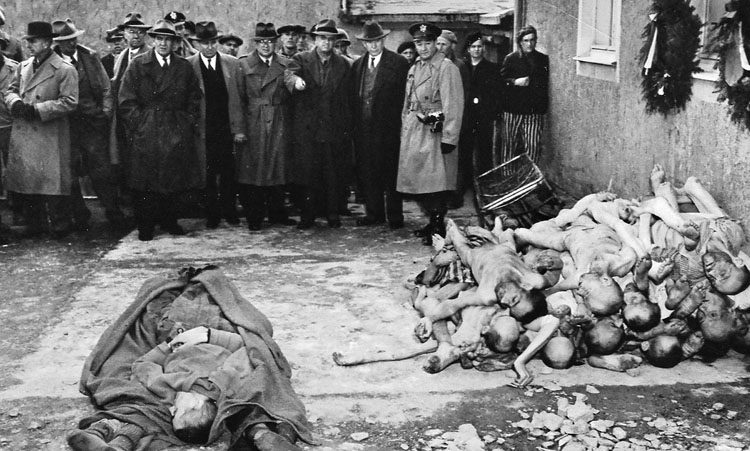
The average 4th Armored Division GI who saw the horrors of Ohrdruf also had something to say about them. Sergeant Peter A. Belpulsi said, “It made me vomit.” Pfc. Richard C. Lukehart noted, “It was horror beyond belief.” After the war, T/3 Norman Sue said that so few people believed the scenes of degradation he described that he stopped trying to describe them.
At one point during the tour, a young American enlisted man accidentally bumped into a former Ohrdruf guard and laughed nervously. Codman wrote, “General Eisenhower fixed [the GI] with a cold eye and when he spoke, each word was like the drop off an icicle. ‘Still having trouble hating them?’” Ike asked.
When the revolting, stomach-churning tour of the abattoir was concluded, Ike turned grimly to the others and said, “I want every American unit not actually in the front lines to see this place. We are told that the American soldier does not know what he is fighting for. Now, at least, he will know what he is fighting against.”
U.S. Navy Captain Harry C. Butcher, Eisenhower’s naval aide, noted, “Ike said he had forced himself to see the bodies, as he wanted to be able to have firsthand evidence to combat anyone in the future who would say that stories of the atrocities were ‘propaganda.’”
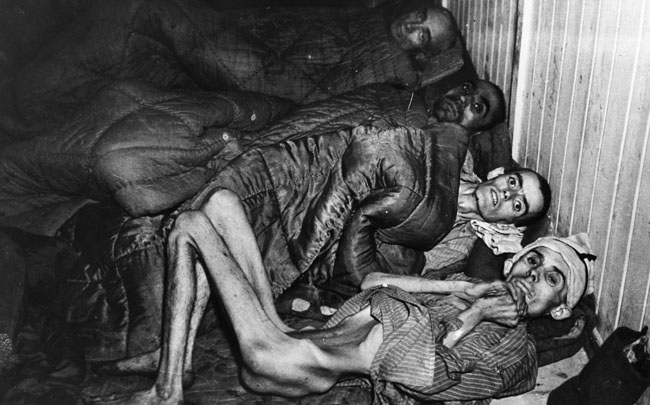
Butcher said, “I told him I thought we should give responsible people at home an opportunity to see the ghastly scenes for themselves. He is planning to ask the War Department to select a group of editors and publishers to visit the camps.”
Eisenhower did just that. He wrote to General George C. Marshall, the Army Chief of Staff in Washington, D.C.: “The things I saw [at Ohrdruf] beggar description…. I made the visit deliberately, in order to be in a position to give firsthand evidence of these things if ever, in the future, there develops a tendency to charge these allegations merely to propaganda.”
War correspondent Meyer Levin, accompanying the high-ranking officers, wrote, “We had known this. The world had vaguely heard. But until now, no one of us had looked on this…. It was as though we had penetrated at last to the center of the black heart, to the very crawling inside of the vicious heart.”
Codman’s Account of Buchenwald
And, as if the discoveries of Ohrdruf and Merkers weren’t enough for one day, there was still one more bombshell remaining. Late that night, back at his headquarters, Patton noticed that his watch had stopped. Before going to bed, he turned on the BBC broadcast to get the correct time and heard the news that the American president, Franklin Delano Roosevelt, had died that day.
With most of the news taken up with the coverage of FDR’s death, the story of the Buchenwald concentration camp’s liberation was “buried” deep inside the New York Times’ April 13 edition. Until that day, the name and even the existence of Buchenwald was, arguably, unknown to most Americans.
Ike sent communiqués to both Washington and London, “urging the two governments to send instantly to Germany a random group of newspaper editors and representative groups from the national legislatures. I felt that the evidence should be immediately placed before the American and British publics in a fashion that would leave no room for cynical doubt.”
Now a new report came into Patton’s headquarters. Patton had just heard about Buchenwald and he steeled himself to visit it. In a letter to his wife Bea, he wrote, “Ohrdruf was the first, and all of us prayed the last, concentration camp any of us would ever see. No such luck. Within 48 hours, XX Corps had overrun a far bigger one north of Weimar, the notorious Buchenwald….”
Upon receiving word of the 6th Armored’s discovery atop the Ettersberg, Patton ordered his aide, Colonel Codman, to alert hospital teams to the situation, get food up the hill, then get himself to Buchenwald immediately and return with a full report. Codman made the calls, arranged for some photographers, and then, accompanied by the Third Army’s French liaison officer, drove to Weimar as fast as possible.
The two men passed through the rubble-strewn streets of Weimar then headed up the “Blood Road” to the camp. Codman saw the main gate to the prisoner enclosure—the punishment “bunker” and wooden tower from which a black flag flew, erected by the inmates on April 13 when they received the news of Roosevelt’s death—describing the gate thusly: “If you didn’t know what it was, you might take it for the entrance to a third-rate amusement park.”
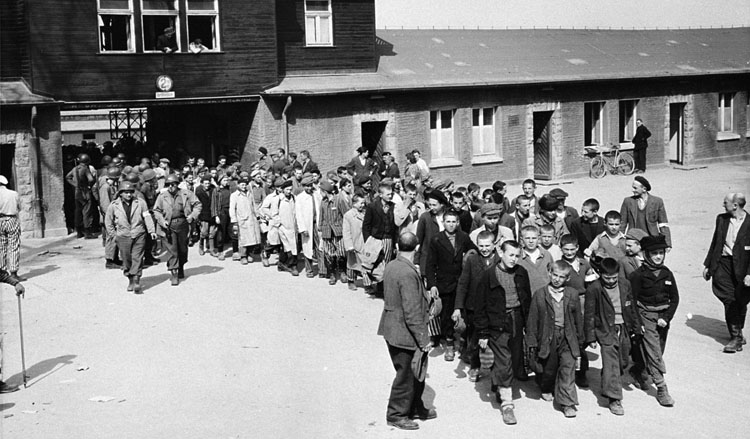
Once inside the camp, Codman and the French liaison officer were met by a greeting party of high-ranking French officers—political prisoners who had been incarcerated for “crimes against the Reich.” The two visitors were shown the crematorium and, outside it, a wagon stacked with 30 or 40 naked corpses. Codman noted, “Prisoners who died from ‘natural causes’ were simply carted into the ground floor of the crematory proper and tossed into six coke ovens, in which are still to be seen the charred remains of the last overhasty and incomplete job that the arrival of our troops interrupted.”
Codman then described what he was told about the fate that awaited those who were brought in for execution: “Here, according to eyewitnesses … were brought prisoners condemned of capital crimes—for example, attempting to escape, insubordination, stealing a potato, smiling in ranks—usually in groups of 20 or so at a time.
“They were lined up against the walls [in the basement] each one under a hook fixed at a height of about eight feet from the floor…. A short, slip-noose was placed about the neck of the condemned, who was then raised by the guards the distance necessary to affix the end of the noose to the hook.” The dead inmate was then placed on an elevator that lifted him directly to the ovens.
Codman and the French liaison officer were then guided to the killing chamber of Block 61 to witness the conditions there, where they found some inmates who were still alive. “An emaciated specter of a man who had managed to get to the latrine and back was attempting to crawl up onto the first shelf [of the bunk bed],” wrote Codman. “It was only three feet from the floor, but he could not make it…. Two of the inmates who accompanied us picked him up by the shoulders and placed him on the shelf. So much for Barrack 61. Barrack 47 was like it, but frankly, I hadn’t the stomach.”
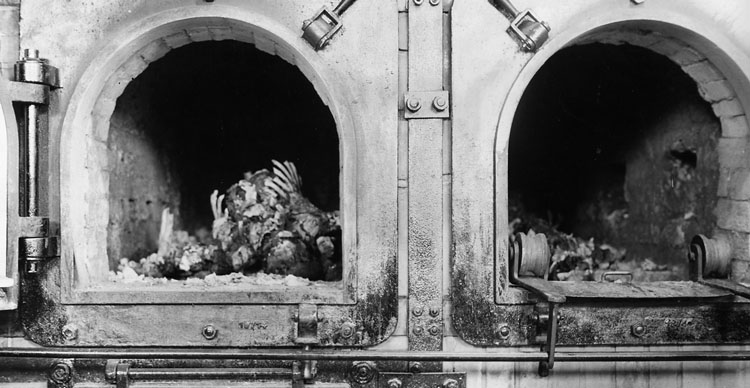
Fluent in French, Codman conferred with a number of now freed French inmates about their experiences and came away sickened at the violence, the sadism, the diabolical methods of torture, the sheer inhumanity that had reigned supreme at the camp.
After returning to headquarters, he wrote to his wife, “I have taken a bath, changed my clothes, smoked two packs of cigarettes, but the overpowering moral and physical stench of Barrack 61 remains in my nostrils—the sour-sweet stench of death, dysentery, and despair. Perhaps it is meant to.”
On the same day of the Army brass visit to Ohrdruf, April 12, members of the 2nd Battalion of the 80th Division’s 319th Infantry Regiment marched into Weimar’s destroyed main square. Two thousand citizens were there, many waving and cheering as though they were being liberated, while a few hard liners turned their backs on their conquerors. The Weimar police force also lined up in the streets and turned over their weapons to the Yanks. From the windows and balconies of Weimar’s shattered buildings, where once Nazi flags were proudly draped, there fluttered only white flags of surrender.
After learning about the existence of the Buchenwald concentration camp, about 60 soldiers from the 80th Infantry Division arrived and probed into the camp, where they encountered hundreds of children—dirty, ragged, emaciated but still alive. Somehow the adult inmates had hidden them for months in anticipation of just this day.
One historian wrote, “The soldiers went from barracks to barracks until they reached Barracks number 66. What they saw there magnified their horror. Hundreds of children, all boys, silently gazed at them with huge, deep-set eyes from faces resembling those of elderly men. They were Jewish children from Poland and Hungary aged eight to twenty.”
The American commander sent out a message to higher headquarters: “Have found a thousand Jewish children in Buchenwald. Take immediate measures to evacuate them.”
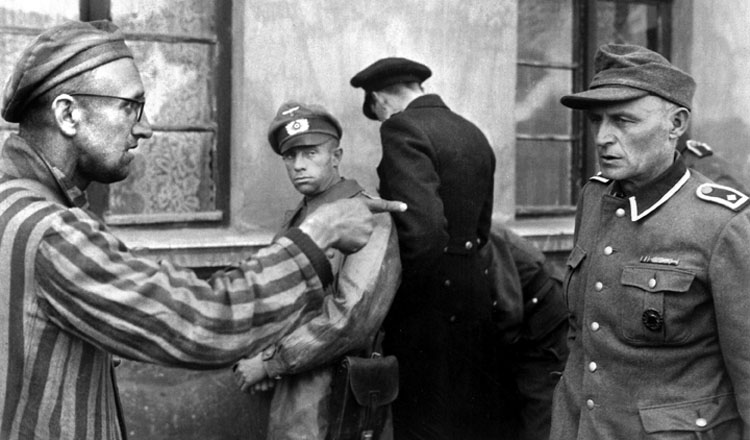
The 80th Division supply officer was also directed to procure as many blankets as possible for the freed inmates of Buchenwald. Plenty of food was also found in the camp larder: 3,000 loaves of bread, 150 tons of potatoes, 30 to 40 tons of rye grits, and 30 tons of margarine. Additionally, the clothing warehouse contained a large supply of shoes and clothing.
The soldiers looked at the abundance stored at Buchenwald and then at the emaciated prisoners in their filthy, worn-out rags and wooden shoes, and just shook their heads in anger at the incomprehensible unfairness of it all. Someone would have to pay for this, they vowed.
“Animated Mummies”
Three days later, Patton traveled to Weimar, where he planned to set up his next headquarters, but first he wanted to see Buchenwald. Although he knew that it would make him sick again, he, along with Walton Walker, commander of XX Corps, were taken by jeep up to see the camp atop the Ettersberg.
No matter how revolted he had been by Ohrdruf, Patton noted in his memoirs that the Buchenwald concentration camp “was apparently much worse than the one at Ohrdruf.”
“This camp was in the vicinity of a factory largely engaged in the construction of parts for the V-1 bomb [actually, it was the V-2] and of artillery caisson,” Patton wrote, “and is a monument to the accurate bombing of our air force [on August 24, 1944], because they completely eliminated the factory without putting a single bomb in the camp, which was contiguous.”
Patton also visited the barracks, an experience that thoroughly repulsed him. “I walked through two buildings,” he said, “each with four tiers of bunks on a side. The bunks were at right angles to the gangway and were built so that they sloped slightly toward the front, and so that the fecal matter and other refuse left by the prisoners trickled down under their chins onto the floor, which was at least three inches deep in filth when I went through.”
He also observed that the inmates “looked like feebly animated mummies and seemed to be of the same level of intelligence.” Patton was also escorted to see the crematorium and all its attendant horrors. In the six industrial ovens, there remained evidence of human cremation. Outside the building was a large pile of remains and another stack of bodies that were supposed to have been burned, but the ovens had run out of fuel.
Medical “Research” Conducted on Unwilling Participants
Patton said that his guides also pointed out to him that in Buchenwald, there were a number of eminent physicians whose role was to conduct pseudo-scientific medical research on living inmates.
Patton wrote, “One case was reported in which 800 slaves had been inoculated with an anti-typhus vaccine and then infected with the typhus bug. Of the 800, some 700 died, and the experiment was considered unsatisfactory.” Other experiments tested spotted fever and yellow fever serums and cures for cholera and gas edema.
In fact, Buchenwald had been only one of the Nazis’ primary medical-research centers. The other major concentration camps that were venues for horrendous experiments included Auschwitz, Bergen-Belsen, Dachau, Natzweiler, Treblinka, Ravensbrück, and Sachsenhausen.
Chosen—or volunteering—to conduct the experiments were some of Germany’s leading scientists and doctors from the country’s major hospitals, clinics, institutes, and universities.
All of the experiments were conducted on human guinea pigs—either concentration camp inmates or Soviet prisoners of war—often performed without anesthesia. In addition to the typhus studies, the doctors at the Buchenwald concentration camp used the inmates for experiments such as judging the effectiveness of poisons, or determining what medications best treated serious wounds and burns.
The internal organs of hundreds of victims from these experiments were kept in jars of formaldehyde in Buchenwald’s pathology department. It is said that more than 30,000 organs were thus preserved. Patton was more than revolted by what he saw: he was also incredibly angry.
An anonymous XX Corps corporal recalled seeing Patton leaving the camp: “[Patton] sat stony-faced as he passed by. We found ourselves inside the camp. All about us, the starved, ragged inmates presented a sad picture. We met an English-speaking inmate who guided us. He took us to a barracks where, in bunks, lay the emaciated moribund, those who were obviously dying. It was a macabre scene I can never forget.”
Remembering that Colonel Hayden Sears of the 4th Armored Division had ordered Ohrdruf civilians to tour the camp in their town, Patton decided to do the same in Weimar. He ordered Erich Kloss, the city’s acting mayor, to his headquarters late on April 15 and said that he wanted a thousand citizens to gather the next day and make the five-mile march up the Ettersberg and tour the camp. Now freed inmates would be their tour guides.
Patton also called Eisenhower and “suggested he send senior representatives of the press and photographers to get the horrid details. General Eisenhower not only did this, but also got congressmen to come over.”
He also followed up his phone call with a letter to Ike: “We have found at a place four miles north of Weimar a similar camp, only much worse [than Ohrdruf]. The normal [inmate] population was 25,000, and they died at the rate of about a hundred a day.…
“I told the press to go up there and see it, and then write as much about it as they could. I also called General Bradley last night and suggested that you send selected individuals from the upper strata of the press to look at it, so that you can build another page of the necessary evidence as to the brutality of the Germans.”
On April 16, the thousand Weimar citizens walked through the camp’s main gate. Laid out before them were tables of human organs in jars of formaldehyde, lampshades made from tattooed human skin, and shrunken heads. They were shown torture devices and the gallows. They saw grotesque piles of naked corpses. They were shown the bones of cremated inmates still in the ovens, and mounds of ash that had once been human bones. They were spared nothing. Many citizens broke down crying, while others turned away, refusing to look.
“If I’ve Offended You by this Rather Mild Account of Buchenwald, I’m Not the Least Sorry. I Was There.”
For the next several weeks—even before the final surrender of Germany on May 8, 1945—Buchenwald became a tourist attraction, with the corpses still on display. Based on Ike’s request, George Marshall set in motion visits by U.S. congressmen, senators, and newspaper publishers and editors; the British also sent a parliamentary delegation.
After their tour, the British parliamentary delegation reported, “Such camps as this mark the lowest point of degradation to which humanity has yet descended. The memory of what we saw and heard at Buchenwald will haunt us ineffaceably for many years.”
The next official delegation came from Washington, D.C., on April 21 as part of a group of six senators who had flown to Europe to visit three camps—Buchenwald, Nordhausen, and Dachau. They were followed by 12 members of the U.S. House of Representatives.
The congressional delegation was shaken by what they had seen. Representative John Kunkel told the press, “If you tried to tell the actual facts, you’d get into a story of obscenity and filth that would be unprintable.” Representative Henry Jackson remarked, “We heard atrocity stories from the last war that were not verified, but now we have seen them with our own eyes and they are the most sordid I have ever imagined.” Clare Booth Luce commented, “No one wants to believe these things, but it is important that people know they’re true.”
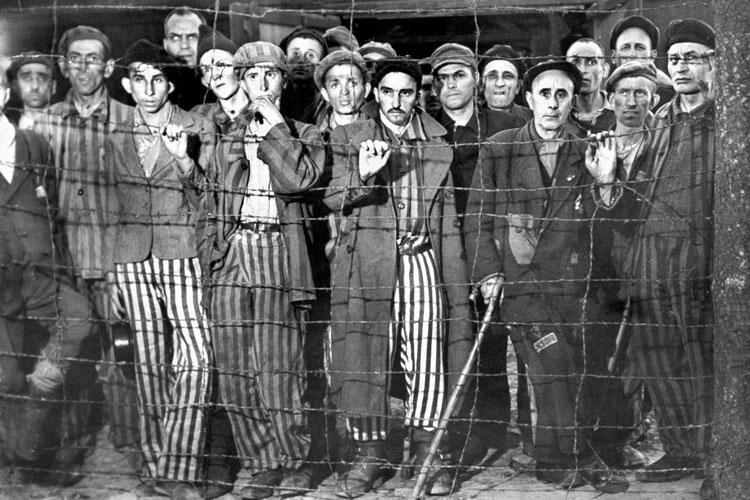
The visit of congressional delegations was followed by a group of a dozen newspaper and magazine publishers, who came on April 24. LIFE magazine photographer Margaret Bourke-White, as well as Army Signal Corps lensmen, arrived to permanently record the scenes of horror.
Joseph Pulitzer III, publisher of the St. Louis Post-Dispatch, said that he had gone to Europe in a skeptical frame of mind, expecting to find many of the terrible reports already relayed by war correspondents exaggerations and largely propaganda.
“It is my grim duty to report,’ Pulitzer wrote, “that the descriptions of the horrors … have given less than the whole truth. The fiendishness of these operations defies description.” He later said that all of Germany’s surviving members of the general staff, Gestapo, SS, and industrialists should be executed “with Army bullets through their heads”—even if it meant killing a million and a half Germans.
Edward R. Murrow, the esteemed radio correspondent, was also there and was unsparing in his descriptions of what he encountered. He told his listeners, “As I entered, I was surrounded by men who tried to lift me up on their shoulders…. They were too weak. Many of them could not even get out of bed. I was told that this building had once accommodated 80 horses. Now there were 1,200 human beings in it, five to every sleeping space. The stench was beyond imagination…
“I pray you to believe what I have said about Buchenwald. I have reported what I saw, but only part of it. For most of it, I have no words…. If I’ve offended you by this rather mild account of Buchenwald, I’m not the least sorry. I was there.”
Laid to Rest
Although 1945 was less than four months old, 13,969 prisoners had already died that year in Buchenwald, while more than 12,000 had perished on the evacuation marches into the countryside.
American officers tried to determine the exact number of persons who died during Buchenwald’s nearly eight years of operation, but it was no easy task. According to SS documents, 33,462 died in Buchenwald and another 23,083 in Buchenwald’s satellite camps. Normally fastidious record-keepers, the Nazis were obviously overwhelmed by the task of recording so many deaths and became sloppy in their accounting practices.
Among those executed before 1944, thousands were listed as “transferred to the Gestapo,” their true number and fate unknown. After 1941, more than 8,000 Soviet POWs were executed en masse and anonymously; their names were not even recorded. Furthermore, prisoners arriving from other camps and selected for immediate execution were not entered into the camp registers.
The commandant, Hermann Pister, was captured by the Allies and put on trial for war crimes. Sentenced to death, he cheated the hangman by dying of a heart attack. The camp’s first commandant, Karl Otto Koch, was executed by an SS firing squad on April 5, 1945, for corruption and embezzlement. His wife, Ilse Koch, implicated in the tattooed human-skin artifacts scandal, was sentenced to life in prison but committed suicide in 1967.
Finally, once the official visits were over, the corpses were removed from the camp and buried at the top of the Ettersberg, where the Americans also forced some 200 Germans to dig seven large mass graves, disinter 500 decomposed corpses, and rebury them. An American officer overseeing the burial detail had little pity on the Germans, who were complaining of the heat and the stench. “Dig, you sons of bitches,” is all he told them.
Patton probably would have said the same thing.
This article is adapted from the author’s 2014 book, Buchenwald: Hell on a Hilltop.
